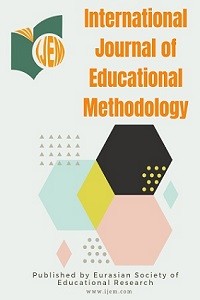Araştırma Makalesi
Yıl 2018,
Cilt: 4 Sayı: 1, 29 - 35, 01.02.2018
Öz
Kaynakça
- Attard Montalto S., Walter, L., Theodorou, M., & Chrysanthou, K. (2016). The CLIL guidebook, 49. Retrieved from https://www.languages.dk/archive/clil4u/book/CLIL Book En.pdf
- Cohen, L., Manion, L., & Morrison, K. (2007). Research Methods in Education, Sixth Edition. Oxon: Routledge.
- Cross, R., & Gearon, M. (2013). Research and evaluation of the Content and Language Integrated Learning (CLIL) approach to teaching and learning languages in Victorian schools, 1–125.
- Heras, A. & Lasagabaster, D. (2015). The impact of CLIL on affective factors and vocabulary learning. Language Teaching Research, 19(1), 70–88
- Lasagabaster, D. (2011). English achievement and student motivation in CLIL and EFL settings. Innovation in Language Learning and Teaching, 5(1), 3–18. https://doi.org/10.1080/17501229.2010.519030
- Lasagabaster, D., & Sierra, J. M. (2009). Immersion and CLIL in English: More differences than similarities. ELT Journal, 64(4), 367–375. https://doi.org/10.1093/elt/ccp082
- Mehisto, P. (2012). Excellence in Bilingual Education A Guide for School Principals. Retrieved from https://scholar.google.co.uk/scholar?hl=en&as_sdt=0%2C5&q=+Excellence+in+bilingual+education%3A+A+guide+for+school+principals&btnG=
- Mehisto, P., Marsh, D., & Frigols, M. (2008). Uncovering CLIL. Content and Language Integrated Learning in Bilingual and Multilingual Education. Macmillan Education. Oxford.
- Novotná, J., & Hofmannová, M. (2000). CLIL and mathematics education. Proceedings of the International Conference on “Mathematics for Living:The Mathematics Education Into the 21st Century Project,” (Clil), 226–230.
- Schonlau, M., Fricker, R. D., & Elliott, M. N. (2002). Conducting research surveys via e-mail and the web. MonographReport MR1480 (Vol. 9). Pittsburgh: RAND. https://doi.org/MR-1480-RC
- Whittaker, R., Llinares, A. & McCabe, A. (2011). Written discourse development in CLIL at secondary school. Language Teaching Research, 15(3), 343–362.
Yıl 2018,
Cilt: 4 Sayı: 1, 29 - 35, 01.02.2018
Öz
This study aims to understand the opinions of middle school and high school students about language learning and studying other content in an additional language in the school settings where English is used as the medium of instruction to teach more than 50% of the curriculum. For this end, 261 students from three different schools were administered a questionnaire. Results indicate students generally have very positive opinions about learning languages and studying content in their non-native language. There is no statistically significant difference between the students’ opinion and their school level, and the years that they have been learning a language and studying content in an additional language. However, the students who have a negative opinion about the school have negative opinions about learning languages and studying content in an additional language. The possible reasons for these were evaluated from the perspective of language learning context but further study would be needed to establish causality.
Anahtar Kelimeler
Kaynakça
- Attard Montalto S., Walter, L., Theodorou, M., & Chrysanthou, K. (2016). The CLIL guidebook, 49. Retrieved from https://www.languages.dk/archive/clil4u/book/CLIL Book En.pdf
- Cohen, L., Manion, L., & Morrison, K. (2007). Research Methods in Education, Sixth Edition. Oxon: Routledge.
- Cross, R., & Gearon, M. (2013). Research and evaluation of the Content and Language Integrated Learning (CLIL) approach to teaching and learning languages in Victorian schools, 1–125.
- Heras, A. & Lasagabaster, D. (2015). The impact of CLIL on affective factors and vocabulary learning. Language Teaching Research, 19(1), 70–88
- Lasagabaster, D. (2011). English achievement and student motivation in CLIL and EFL settings. Innovation in Language Learning and Teaching, 5(1), 3–18. https://doi.org/10.1080/17501229.2010.519030
- Lasagabaster, D., & Sierra, J. M. (2009). Immersion and CLIL in English: More differences than similarities. ELT Journal, 64(4), 367–375. https://doi.org/10.1093/elt/ccp082
- Mehisto, P. (2012). Excellence in Bilingual Education A Guide for School Principals. Retrieved from https://scholar.google.co.uk/scholar?hl=en&as_sdt=0%2C5&q=+Excellence+in+bilingual+education%3A+A+guide+for+school+principals&btnG=
- Mehisto, P., Marsh, D., & Frigols, M. (2008). Uncovering CLIL. Content and Language Integrated Learning in Bilingual and Multilingual Education. Macmillan Education. Oxford.
- Novotná, J., & Hofmannová, M. (2000). CLIL and mathematics education. Proceedings of the International Conference on “Mathematics for Living:The Mathematics Education Into the 21st Century Project,” (Clil), 226–230.
- Schonlau, M., Fricker, R. D., & Elliott, M. N. (2002). Conducting research surveys via e-mail and the web. MonographReport MR1480 (Vol. 9). Pittsburgh: RAND. https://doi.org/MR-1480-RC
- Whittaker, R., Llinares, A. & McCabe, A. (2011). Written discourse development in CLIL at secondary school. Language Teaching Research, 15(3), 343–362.
Toplam 11 adet kaynakça vardır.
Ayrıntılar
| Birincil Dil | İngilizce |
|---|---|
| Konular | Eğitim Üzerine Çalışmalar |
| Diğer ID | JA28UJ82EN |
| Bölüm | Araştırma Makalesi |
| Yazarlar | |
| Yayımlanma Tarihi | 1 Şubat 2018 |
| Yayımlandığı Sayı | Yıl 2018 Cilt: 4 Sayı: 1 |

